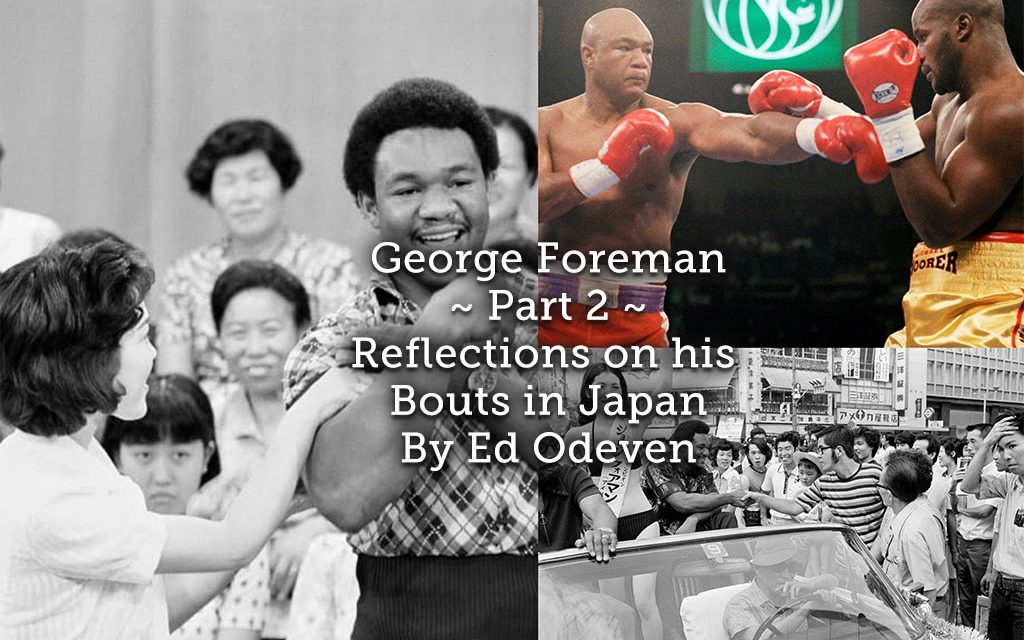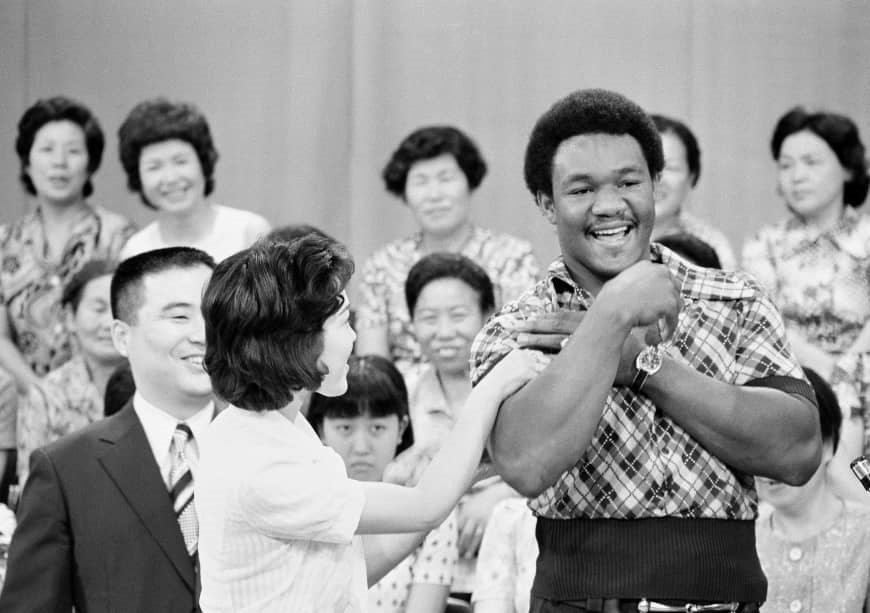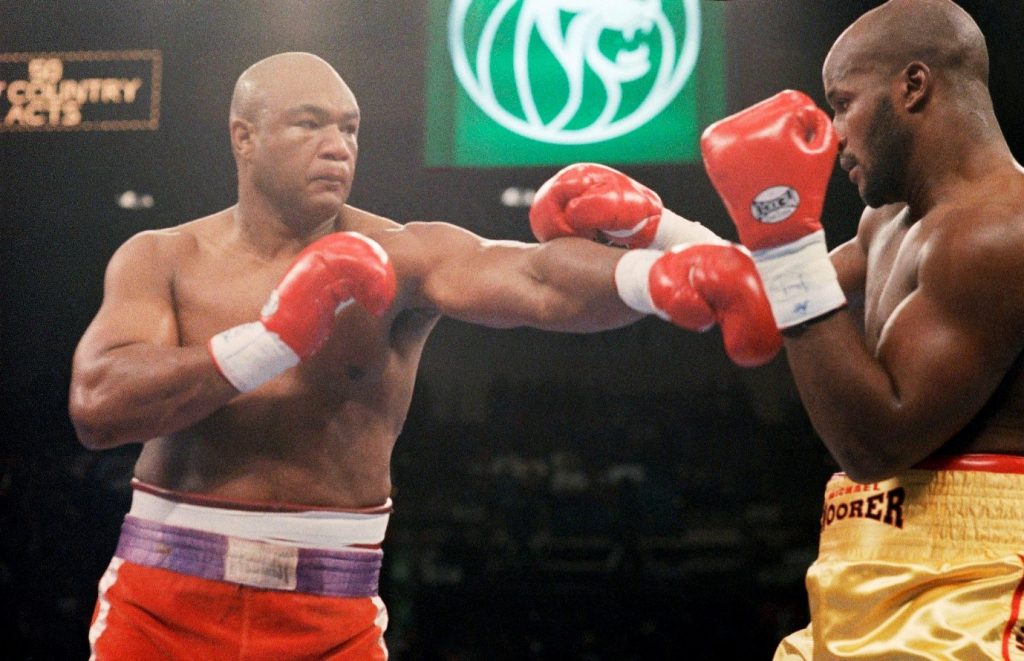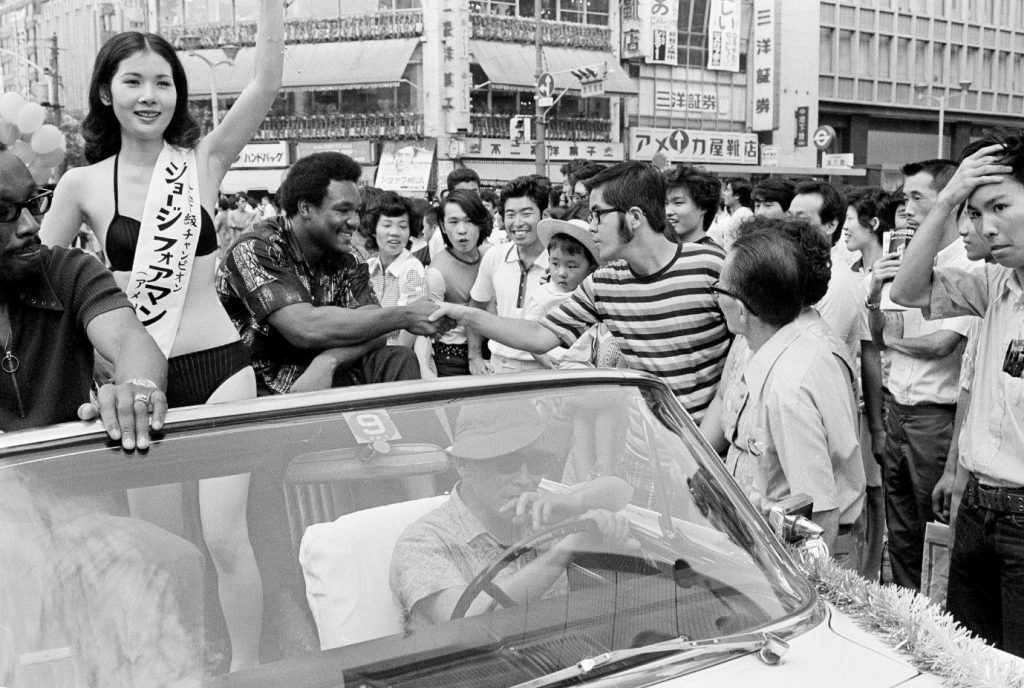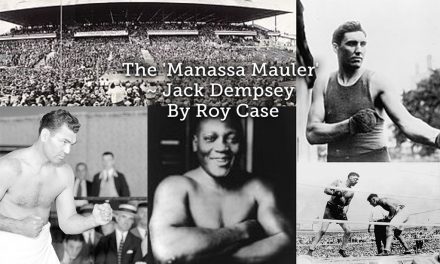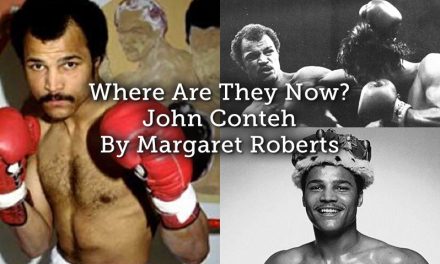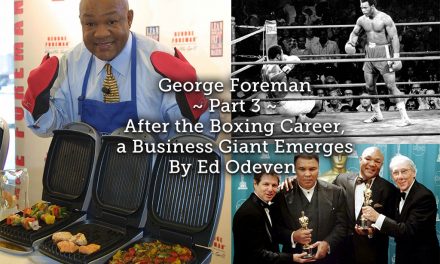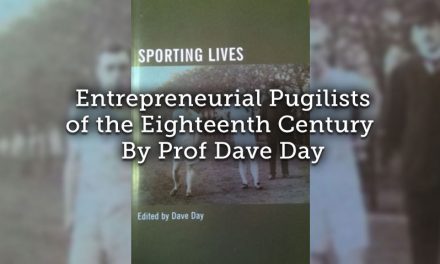Missed Part 1? Click on the link – https://goo.gl/xeznsf
When he was presumably closer to retirement home age than prime-time sports figure, George Foreman produced one of the most stunning feats in modern sports history.
Foreman’s 10th-round knockout of Michael Moorer in Las Vegas on Nov. 5, 1994, made him the oldest heavyweight boxing champ in history. He was 45 years, 360 days old. An ancient man in a young man’s sport. (The former oldest heavyweight champ, Jersey Joe Walcott, was 37 when he achieved the feat with a seven-round KO of Ezzard Charles on July 18, 1951, in Pittsburgh.)
- TV talk show host Akiko Kataoka admires the muscles of heavyweight champion George Foreman during an appearance in Tokyo in July 1973. | AP
By becoming heavyweight champion for the second time, Foreman ensured a more prominent place for himself in the annals of the sport — nearly two full decades after going toe-to-toe with Joe Frazier (dropping the legend six times in two rounds in 1973 in Kingston, Jamaica, to become title holder) and then challenger Muhammad Ali (losing via an eighth-round KO in the Rumble in the Jungle on Oct. 30, 1974, in Kinshasa, Zaire).
“He had my number”, Foreman said of Ali. “He had my number, that’s all. But I had Joe Frazier’s number, Michael Moorer’s number, Ken Norton’s . . . I had almost 80-something people’s numbers, but Muhammad Ali had my number. I can’t change that.”
In a recent interview, Foreman, now 69, analyzed what happened inside the squared circle against Moorer, who was 27 at the time. He also spoke in detail about his two fights in Japan, which took place 23 years apart and nearly bookended a legendary career.
Against Moorer, Foreman believes that he outsmarted the New York City native, and that his strategy was superior.
“I knew I wouldn’t be able to win the fight by points because of what happened with (Tommy Morrison),” told The Japan Times by phone from his ranch in Marshall, Texas. Morrison defeated Foreman by unanimous decision in their 12-round fight for the vacant World Boxing Organization heavyweight title on June 7, 1993, in Las Vegas. Foreman continued: “I knew I’d have to get a knockout, and I knew I wouldn’t be able to do it in the first or second round. I’d have to do it later.”
For Big George, who had retired in 1977, become a Christian preacher and returned to the ring a decade later in a much-publicized successful comeback, veteran experience paid off. The Moorer fight was a showcase for his still-present skills. (Various insights on his post-fighting life are included in the third installment.)
- Challenger George Foreman throws a punch at heavyweight champ Michael Moorer during their title fight on Nov. 5, 1994, in Las Vegas. Foreman, then 45, knocked out the 27-year-old Moorer in the 10th round to regain the crown
In other words, the strategy to exhibit patience with Moorer, a former light heavyweight champion, was spot-on.
“Michael Moorer believed he was the better puncher,” recalled Foreman, who never sparred with or fought against Mike Tyson. “At the fighters’ meeting they asked which gloves we were going to use. Michael Moorer insisted on the Cleto Reyes glove. We call them the puncher’s glove. Most times, when people fight me they try to go to the Everlast gloves, because it’s like they have air in them, and they’re not the complement of a puncher; they are mostly a glove you can box on a guy with. And I said, ‘Is he crazy?’ He actually believed that he was the puncher and that I was a boxer. I said, ‘Man, this thing is falling into my hands everywhere I go.’ ” He went on: “So I knew if I dropped him at all, it was going to be once and for all, so I waited around and landed body shots, hooks to the side . . . and I karated with him a few times. He, of course, was a better boxer and stayed on the outside. Then finally, he decided he wasn’t going to run from me, and the knockout just presented itself.”
Nearly a quarter century after Foreman recaptured the world heavyweight title — the WBA and IBF versions — in the confusing alphabet-soup organizational landscape of pro boxing — he credited Moorer for demonstrating bravery in their mano a mano clash.
“He didn’t run from me, he didn’t hide,” Foreman said of Moorer.
There remains, however, a misconception that has been published in various articles about the knockout artist’s attire for the Moorer fight, he said.
Given the chance to set the record straight, Foreman said he didn’t wear the same trunks against Moorer that he had donned for the Rumble in the Jungle.
“Everlast made a series of (customized) boxing trunks for me,” he told The Japan Times. “And the trunks I fought in I had fought in when I was heavyweight champion of the world (in the 1970s), but they were not the trunks that I fought Muhammad Ali in. They were just trunks I had fought in as the heavyweight champion of the world.” Perhaps against Ken Norton, he added. “People keep making that story (up),” he went on, “but I tell them these trunks said ‘George Foreman, heavyweight champion of the world,’ they had lasted all those years, so I put on my world heavyweight championship trunks to get in the ring (with Moorer). “I’m a minister now, so I’m not just gonna lie, you know what I mean? I’m just not gonna do it.”
First title defense in Tokyo
Foreman, the 1968 Olympic heavyweight champion in Mexico City, retains vivid memories of his first fight in Japan. He defended his WBA and WBC titles on Sept. 1, 1973, at Nippon Budokan against Puerto Rican challenger Jose Roman.
The beatdown lasted exactly two minutes for the new world champ.
“I remember that fight and it was brutal,” Foreman told this newspaper. “It didn’t last long, but I was in my most brutal moment of my boxing career. . . . And I was always told, ‘George, don’t try to hit a guy on the top of the head or on the side of the top of the head, you’ll hurt your hands and you can hardly knock him out. You’ve got to hit him on the chin or close to the jaw.’ ”
Truth be told, Foreman didn’t follow that advice against Roman, who was appearing in his 52nd pro fight. But his punches produced the desired results.
“Well, this time I hit Roman right on the side of the top of his head,” Foreman recounted, “not on the middle part of his head . . . and I knocked him down and I said there, ‘I’m the hardest puncher that ever put on a pair of boxing gloves.’ ”
How was Roman’s condition afterward?
“He recovered good because the good thing about my punches is it’s not like the boxers who have to hit a guy a hundred times,” Foreman stated. “If I threw five shots and hit a guy once, it was gonna knock him down.
“I would pretty much knock them down, and that was pretty much their salvation that they would get knocked down.”
Against Roman, Foreman believes that he delivered those blows like a sledgehammer.
“Those punches,” he said, “were the most brutal I’ve ever (delivered) before or since in a boxing match.”
Powerful words from a fighter who recorded 68 — count ’em 68 — knockout victories in 76 pro bouts.
- Heavyweight champion George Foreman shakes hands with a Tokyo resident during a parade through Ginza in 1973 ahead of his title bout with Jose Roman.
Donated portion of winnings
Foreman donated $10,000 from his Roman fight earnings to a home for handicapped children in Japan, according to news reports at the time. He couldn’t recall the name of the home, which didn’t appear in 1973 articles.
Asked if he had visited that home, Foreman said that he didn’t. But he stopped by other homes that supported children in need in the years that followed.
One of those homes, the Elizabeth Saunders Home, was established in 1948 in Oiso, Kanagawa Prefecture, to support biracial children, many of whom were abandoned, and Japanese mothers in the aftermath of World War II. The orphanage, affiliated with the Anglican Church of Japan, was named in honor of an Englishwoman who was the first person to donate money. (The home, still in operation, was established by Miki Sawada. Her grandfather, Yataro Iwasaki, founded the Mitsubishi business empire.)
“I visited her place and made sure she got a donation,” Foreman said of Sawada, who passed away in 1980 at age 78. “And a couple of kids from her place even became good boxers.”
That visit had a profound impact on Foreman. He called it the “most touching part of my life.”
Learning about Japan’s recovery from World War II from afar, as well as from earthquakes and other natural disasters over the years, including the Great East Japan Earthquake on March 11, 2011, Foreman paid tribute to the character of this nation’s people.
“You’ve got to understand that the people in Japan are the most resilient people in the whole world,” Foreman said.
Foreman estimates he’s made five visits to Japan over the years for work and leisure, including as a cast member of “Better Late Than Never,” a TV reality-travel program (and remake of the popular South Korean show “Grandpas Over Flowers” that also featured actors William Shatner and Henry Winkler, NFL Hall of Fame quarterback Terry Bradshaw and comedian Jeff Dye. In August 2015, production work began for the show in Japan. Season 1 aired in 2016 on American TV network NBC and included stops in Tokyo and Kyoto, among other locales in Japan and East Asia.
The show’s concept was straight forward: “The stars will travel around the world, experience new cultures and take another step in checking off their bucket lists,” The Korea Times reported.
Besides work for the TV show, Foreman was able to see Japan up close like he’d never done before.
“I got a chance to really meet people,” he said. “It was the best trip I ever had. There was so much to offer me that I didn’t know about. I thought I loved Japan, but I didn’t (really) know Japan until that ‘Better Late Than Never’ show.”
Showdown with Grimsley
Foreman encountered Crawford Grimsley at Tokyo Bay NK Hall in Urayasu, Chiba Prefecture, on Nov. 3, 1996, in a non-title fight that he won by outpointing his lesser-known foe. (Due to inactivity — e.g. not defending his titles — Foreman was stripped of his WBA and IBF belts in 1995.)
It was Grimsley’s first loss in 21 career fights up to that day. Foreman fought twice more before retiring for good.
“I tried to get him every chance I could … but the 12 rounds went by really quick,” Foreman said, looking back on the bout. “But I expected that decision because I was after him every inch of the way.”
Angelo Dundee, Ali’s legendary trainer (1960-81), worked in Foreman’s corner.
Foreman remembered it as “a more reserved (crowd) than at other places around the world.”
“Some good-mannered people, more so than some people. I could’ve had the same fight in upstate New York and everybody would’ve been cussing and throwing stuff,” he added with a laugh.
What’s more, the day of the fight provided an unexpected, memorable experience for Foreman: He met MLB superstar Barry Bonds for the first time.
“He came up into the ring and shook my hand. That was the highlight of the whole fight for me,” said Foreman, who described Evander Holyfield and Ali as the smartest boxers he ever faced.
Article © Ed Odeven
Reprinted by kind permission of the author, first published in the Japan Times (https://goo.gl/fTDzz7)
To read Part 3 click HERE

